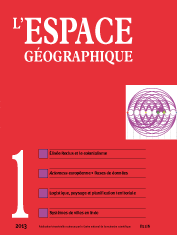

Imperial science and heterodox discourses: Élisée Reclus and French colonialism
The geographical works by Élisée Reclus which were very well-known in Europe the second half of the 19th century, were at the time among the main encyclopaedic references where both scholars and cultivated readers could find ethnographic and geographic information on non-European countries. As Reclus was not only a famous geographer, but also a protagonist of the foundation of the international socialist and anarchist movement, an analysis of these sources is very important to obtain information on the tendencies of the progressive French and European public opinion in the colonial age. This paper deals with the part of Reclus’ work dedicated to the French colonialism, analysing his work and his archives, and comparing them with the existing literature, with a special focus on the paradigmatic case of occupation of Algeria.
keywords: ALGERIA, FRENCH COLONIALISM, POSTCOLONIAL STUDIES, RECLUS
The European Union as an actor in international relations. A geographical assessment of European actorness (4 fig., 3 tabl.)
This paper studies EU actorness, i.e. its ability to influence international relations and to impose its values on a global scale. By offering a geographical interpretation of actorness criteria, the authors attempt to define the extent to which a political entity can be seen as an actor in international relations. This approach is applied to the European Union, focusing on three criteria of the actorness: opportunity, consistency and effectiveness. This method leads to the conclusion that the European Union is an incomplete and fragile actor insofar as it displays low levels actorness in certain areas.
keywords: ACTORNESS, EUROPEAN UNION, INTERNATIONAL RELATIONS, INTERNATIONAL TREATY
Logistics sites – between networks and territories (4 fig., 1 tabl.)
Warehouses are essential parts of production and distribution systems. Their proliferation in peri-urban spaces has encouraged local economic development. However, it has also spread the nuisance of the road freight transport system. Local governments have therefore started to consider the issue of spatial planning for logistics. This article highlights the current mechanisms of establishing warehouses. They are the result of network issues tied to transport and logistics firms and result in opportunist and transient locations. However, territorial stakes, which depend mainly on local governments, are gaining in importance. In the future, the capacity of local, public authorities to govern could become an essential element in the regulation of logistic sites.
keywords: ESTABLISHMENT, FLOW, LOGISTIC, NETWORK, TERRITORY, REGULATION
The landscape – a catalyst for territorial planning (4 fig., 2 photos, 1 tabl.)
The evolution of the regulatory framework and of the governance systems has distinctly intensified the role of the notion of landscape in urban planning tools. Based on the assessment of the landscape policy of Bordeaux’s metropolitan urban plan, this article presents an appraisal of the result. The use of the notion of landscape is a tool to mobilize actors and temporally anchor local development processes. Between the stakes of economic development and the expectations of local populations, landscape approaches have become a device that can improve the efficiency of the tools of public action.
keywords: LANDSCAPE, MASTER PLAN, PUBLIC ACTION, PUBLIC POLICY ASSESSMENT, URBAN PLANNING
Resolutions of landcover databases and assessment of change. Articulations of space, time and theme (6 fig., 1 tabl.)
Landuse/landcover databases, produced by the authorities, are commonly used to study topics as diverse as the abandonment of agricultural land, urban sprawl or the design of green infrastructure programmes. Although data providers have issued warnings about the limits of their product, most users have not questioned the performance of these databases in terms of spatial, temporal or thematic resolution. By comparing three available databases (CORINE Land Cover, LittoMOS and IPLI) on a coastal area (the Arcachon bay, in southwestern France), we show the importance of including these resolutions to validate the state and changes of land cover and land use.
keywords: LAND COVER, LAND USE, SPACE, THEMATIC RESOLUTION, TIME
Statistical approach to territorial cohesion: The system of cities in India (7 fig., 3 tabl.)
India has a rich and ancient history, characterized by the advent of successive kingdoms and urban civilizations and the succession of political and territorial decomposition and recomposition during the 20th century. From the point of view of the dynamics of the city system, Indian territory raises the question of the degree of integration of a set of cities. This article shows that there is both a unity of the Indian city system, characterized by a homogeneous distributed growth process for more than a century, as well as a regional diversity, revealed by the heterogeneity from one region to another of the degree of inequality with respect to the size of the cities and their growth rates.
keywords: GIBRAT’S LAW, INDIA RANG-SIZE RULE, CITY SYSTEM, TERRITORIAL COHESION, TRAJECTORY OF CITIES, URBAN GROWTH
Book reviews
In this issue of l’Espace géographique, you will find critical reviews of the following books
GUNNELL Y. (2009). Écologie et société. Paris : A. Colin, 418 p. (Philippe Pelletier, université Lumière-Lyon 2)
MATHEVET R. (2012). La Solidarité écologique, ce lien qui nous oblige. Arles: Actes Sud, 214 p. (Philippe Pelletier, université Lumière-Lyon 2)
PAPY F., MATHIEU N., FÉRAULT C. (2012). Nouveaux rapports à la nature dans les campagnes. Paris: éditions Quae, 191 p. (Yves Guermond, université de Rouen)
MICHAUD Y. (2009). Ibiza mon amour. Enquête sur l’industrialisation du plaisir. Paris: Nil éditions, 352 p. (Jean-Christophe Gay, université Nice-Sophia-Antipolis)
L’espace géographique 4/12![]()
![]() L’espace géographique 2/13
L’espace géographique 2/13
For subscribe or buy this issue: BELIN
![]() L’Espace géographique: contents
L’Espace géographique: contents
Last modified: April 10, 2013